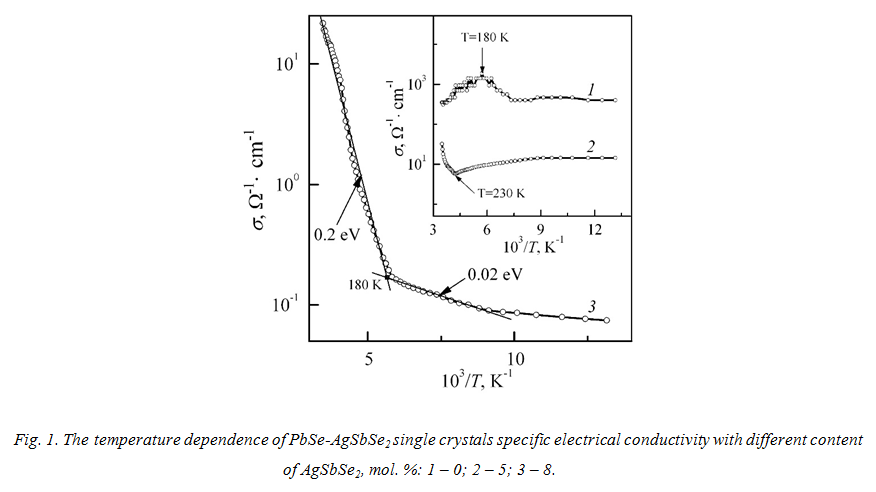Bridgman’s horizontal method was used for growing of single crystals. Detailed synthesis samples, methods of crystal growth and phase equilibrium diagram of the PbSe-AgSbSe2 system are presented in [1, 2]. Single crystals of PbSe-AgSbSe2 solid solution complied with blend composition of 0, 5 and 8 mol% AgSbSe2. The research of temperature dependence of PbSe-AgSbSe2 single crystals’ electrical conductivity was carried out in the temperature range of 77-300 K. The samples with an average size of 6×2×1 mm3 were used for this research.
The research results of the temperature dependence of the electrical conductivity of single crystals PbSe-AgSbSe2 are presented in Fig.1. At low temperatures (~77-180 K), electrical conductivity (σ) of single crystals PbSe (0 mol.% AgSbSe2) remained almost unchanged on temperature shift, what accords with work data [1], according to which the state of PbSe single crystals is close to degenerated one, because concentration holes in PbSe at room temperature p≈6 1018 cm-3. At the temperature range of 180-300 K ~ σ decreases with increasing temperature, which may indicate the onset of metallic conductivity.
The samples of 5 mоl. % AgSbSе2 have showed the properties similar to those ones of the degenerated semiconductor at the temperature range of 77-230 K. At T = 230 K there is a sharp change in electrical properties (Fig. 1.2) of single crystals of this volume components, which may be due to a change in the mechanism of metallic conductivity into semiconductor one (Mott transition).
Temperature dependence of the electrical conductivity of single crystals of 92 % PbSe–8% AgSbSe2 at temperatures 180-300 K ~ can be described by the dependency:
Please use another browser to view content
which is set in accordance to the slope σ(T) in the Arrhenius coordinates (Fig. 1.3) thermal activation energy (ЕА) was ЕА1≈0,2 еV; prior multiplier was σА≈105 Om ∙ cm-1. It is known that the value σA is inherent for transitions of carriers from defect centers in the bandgap, which are close to the Fermi level (Еf), to the delocalized states of permitted band [5], in our case, to the flow below of the valence band. Obviously, the conductivity in the temperature range of 180-300 K is a particular conductivity. In such case the provisions Еf is close to the middle of the semiconductor bandgap (Еf=Еg/2). Respective, the thermal bright of the bandgap is Еg=2 ЕА≈0,4 eV.
At the temperature range of 120-180 K the dependence σ(T) is exponential (Fig.1). In accordance with the slope σ(T) the determined activation energy values were ЕА2≈0,02 eV. Considering that the studied crystals appeared to be compounds of p-type conductivity, the temperature activation energy ЕА≈0,02 eV in the temperature range 120-180 K can be interpreted by thermal excitation holes of shallow acceptor centers in the valence band.
References:
1. Електричні, гальваномагнітні та термоелектричні властивості твердих розчинів PbSe–AgSbSe2 / О. В. Новосад, Н. А. Божко, О. Ф. Змій [та ін.] // Наук. вісн. Східноєвроп. нац. ун-ту ім. Лесі Українки: Фіз. науки. – 2013. – №. 26. – С. 21–26.
2. Взаємодія компонентів AgSbSe2 і PbSe та термоелектричні властивості твердих розчинів на їх основі / С. А. Федосов, Н. А Божко, О. В. Новосад [та ін.] // Наук. вісн. Східноєвроп. нац. ун-ту ім. Лесі Українки: Фіз. науки. – 2014. – №. 17. – С. 8–14.
3. Specific features of the low-temperature conductivity and photoconductivity of CuInSe2–ZnIn2Se4 alloys / V. V. Bozhko, A. V. Novosad, O. V. Parasyuk [et al.] // Semiconductors. – 2014. – Vol. 48, № 6. – P. 747–752.
4. Электрические свойства (PbSe)x(AgAsSe2)1-x / О. А. Шабашова, Л. Л. Нугаева, О. Л. Хейфец, Н. В. Мельникова // Фазовые переходы, упорядоченные материалы и состояния. – 2006. – № 9–С. 1–2.
5. Мотт Н. Электронные процессы в некристаллических веществах / Н. Мотт, Е. Девис; [пер. с англ. Б. Т. Коломийца]. – М. : Мир, 1974. – 472 с.





